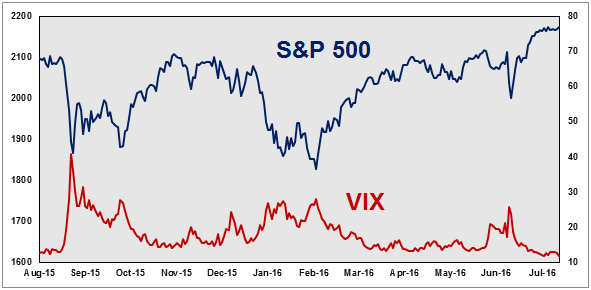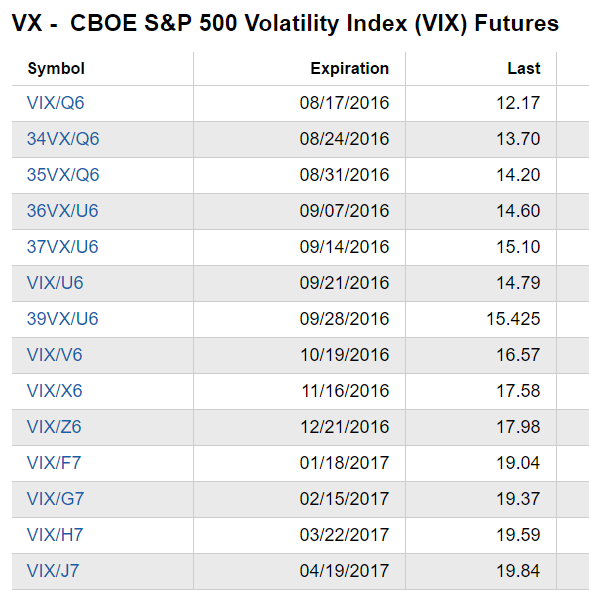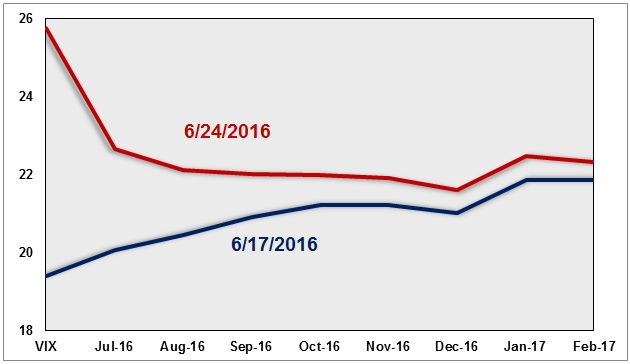The Five Things a Trader Should Know About VIX Futures
By CFE
Over the past decade Volatility has emerged as an asset class with VIX Futures leading the way. Financial futures trading based on the CBOE Volatility Index® (VIX®) was introduced in 2004. This milestone was the first instance of a listed derivative available for trading that gave investors direct exposure to expected market volatility. If you are considering adding volatility to your toolbox of trading and portfolio management methods, there are a few things you should know as you get started.
1. What the CBOE Volatility Index (VIX) Is Measuring
VIX is a consistent measure of near term volatility determined using S&P 500® (SPX) option pricing. There are two different expiring sets of SPX options feeding into the VIX calculation with the two series being time weighted to determine a consistent 30-day measure of implied volatility. When the S&P 500 comes under pressure the demand for SPX put options increases which often pushes VIX higher. VIX was given the nickname, “The Fear Index” because of this increased demand for portfolio protection at times when the market is under pressure.
2. Relationship Between VIX and The S&P 500
Traders have been conditioned to believe that when the S&P 500 drops VIX rises and when the S&P 500 rises one should expect VIX to move lower. The long term daily price change correlation between the S&P 500 and VIX is very close to -0.75 so this belief has some merit. However, there are days when both the S&P 500 and VIX move in the same direction. In fact, about 20% of trading days VIX and the S&P 500 price changes move in the same direction. The table below breaks down the relationship between VIX and the S&P 500 on days when stocks were higher and days they were lower from January 2004 – July 2016.
Table 1 S&P 500 and VIX Daily Pricing
|
Days
SPX Up
|
Days SPX Up
VIX Down
|
% SPX Up
VIX Down
|
|
1729
|
1423
|
82.3%
|
|
|
|
|
|
Days
SPX Down
|
Days SPX Down / VIX Up
|
%SPX Down
VIX Up
|
|
1435
|
1141
|
79.5%
|
Data Source: Bloomberg
The chart below shows the daily price action in the S&P 500 and VIX from August 2015 to July 2016. Note there are a few instances where the S&P 500 sold off quickly and VIX rallied in response to these equity market sell offs.

Data Source: Bloomberg
1 Contract Specifications for VIX Futures
The notional value of a VIX Futures contract is $1000 times the index. The futures trade in increments of 0.05 or ($50 a tick), but calendar spreads may be quoted in increments of 0.01 ($10 a tick). The hours for VIX Futures trading were expanded to almost 24 hours a day five days a week in June 2014. Spot VIX is also calculated and quoted outside of US trading hours, beginning at 2:15 am Chicago time which coincides with markets opening in Europe.
For just over a year the CBOE Futures Exchange has listed VIX Futures expiring each week for several consecutive weeks. In addition, there are standard VIX Futures contracts that expire each month. Standard expiration is typically on a Wednesday which falls 30-days before the following month’s standard third Friday SPX option expiration date. Figure 2 shows VIX futures quotes from August 15, 2016.
Figure 2 – VIX Futures Pricing 8/15/2016

Data Source: cfe.cboe.com
The quotes above are a combination of VIX Weeklys Futures and standard VIX futures. VIX/Q6 is the standard August VIX contract. The quotes that begin with numbers are VIX Weeklys Futures and the numbers actually represent which week of the year these contracts expire.
1. The VIX Settlement Process
VIX Futures are AM settled contracts. The final settlement value for VIX Futures is a Special Opening Quotation (SOQ) of the VIX Index. The SOQ is calculated using opening prices of constituent SPX or SPX Weeklys options that expire 30 days after the relevant VIX expiration date. The final settlement value for VIX futures is disseminated using the ticker VRO. The last trading day for VIX Futures is the day before settlement so a contract that is due to expire on Wednesday morning will cease trading at 3:15 pm Chicago time the day before settlement. This means a contract set to expire will not trade during non-US hours the day of settlement.
2. Pricing Characteristics of VIX Futures
VIX Futures contracts may trade at a premium or discount to spot VIX and other VIX futures. The majority of trading days VIX Futures are at a premium to spot VIX as well as at a premium to the futures contracts that expire before the expiration date for the individual contract. Figure 3 shows spot VIX and the standard VIX futures contract pricing the Friday before and Friday after the recent Brexit vote.
Figure 3 – VIX and VIX Futures Pricing

Data Sources: Bloomberg and cfe.cboe.com
There are multiple resources available on the CBOE (www.cboe.com) and CBOE Futures Exchange (www.cfe.cboe.com) websites regarding the spot VIX and VIX Futures contracts. In addition, if you are interested to hear how volatility is being used as an asset class, CBOE’s Risk Management Conferences (RMC) can be an excellent educational platform. The European version of RMC is scheduled for September 26 – 28 at the Powerscourt Hotel outside of Dublin, Ireland (www.cboermceurope.com) and RMC Asia is set for November 30 – December 1 at the Conrad Hotel in Hong Kong (www.cboermcasia.com). In our next article, we will unravel interesting observations about the relationship between VIX and the S&P 500.
RISK DISCLAIMER: Trading in futures products entails significant risks of loss which must be understood prior to trading and may not be appropriate for all investors. Past performance of actual trades or strategies cited herein is not necessarily indicative of future performance. The information contained herein is provided to you for information only and believed to be drawn from reliable sources but cannot be guaranteed; Phillip Capital Inc. assumes no responsibility for errors or omissions. The views and opinions expressed in this letter are those of the author and do not reflect the views of Phillip Capital Inc. or its staff.